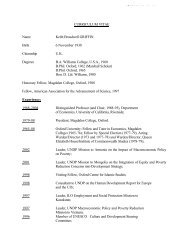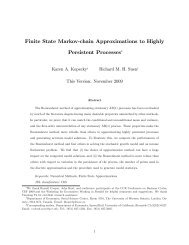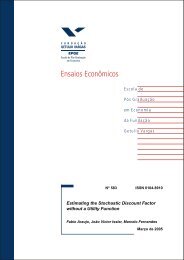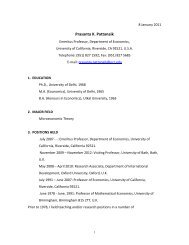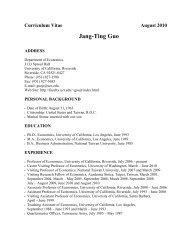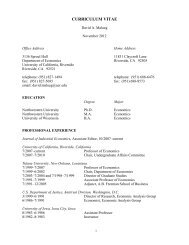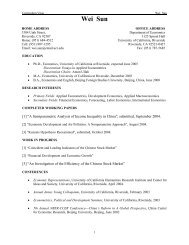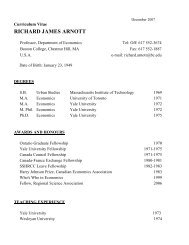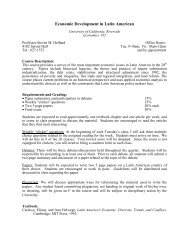Copula-based Multivariate GARCH Model with ... - Economics
Copula-based Multivariate GARCH Model with ... - Economics
Copula-based Multivariate GARCH Model with ... - Economics
Create successful ePaper yourself
Turn your PDF publications into a flip-book with our unique Google optimized e-Paper software.
lower tail dependence (λ L > 0) and zero upper tail dependence (λ U =0). For DM-IL, Gumbel<br />
copula is selected, which has the asymmetric tail dependence <strong>with</strong> positive upper tail dependence<br />
(λ U > 0) and zero lower tail dependence (λ L =0). For the FF-IL pair, the model selection criteria<br />
select Frank copula, which has symmetric tail dependence. 11<br />
For the trivariate system of FF-DM-IL (Table 4A), we compare three C-M<strong>GARCH</strong> models (GS-<br />
G-F-M<strong>GARCH</strong> using Method 1, F-F-F-M<strong>GARCH</strong> using Method 1, and F-F-F-M<strong>GARCH</strong> using<br />
Method 2) <strong>with</strong> the benchmark M<strong>GARCH</strong> (I-I-I-M<strong>GARCH</strong>). The benchmark M<strong>GARCH</strong> yields the<br />
worst values for logL, AIC, and SIC. The best model in terms of these three model selection criteria<br />
istheF-F-F-M<strong>GARCH</strong><strong>with</strong>Method1forDCCandVCfamilies,andtheGS-G-F-M<strong>GARCH</strong><strong>with</strong><br />
Method 1 for SBEKK family. While Method 1 works better than Method 2 in terms of the three<br />
model selection criteria, the performance of Method 2 is quite encouraging as it is only slightly<br />
worse but much simpler to use than Method 1.<br />
Panel A in each of the three tables also presents the estimated copula shape parameters ˆθ R , their<br />
robust standard errors, and the corresponding ˆσ ij obtained from the Hoeffding’s lemma. For FF-<br />
DM (Table 1A), the estimated Gumbel Survival copula parameter ˆθ R =1.10 gives ˆσ 12 =0.14 for<br />
GS-DCC. GS-VC and GS-SBEKK have the similar values for ˆθ R =1.09, 1.08, and for ˆσ 12 =0.13,<br />
0.12, respectively. For DM-IL (Table 2A), the estimated Gumbel copula parameters ˆθ R (= 1.16,<br />
1.19, 1.15) andˆσ 12 (= 0.22, 0.25, 0.20) are bigger than those of FF-DM. For FF-IL (Table 3A), the<br />
estimated Frank copula shape parameter ˆθ R is 3.11 in F-DCC, 3.51 in F-VC, and 3.17 in F-SBEKK,<br />
and all significantly positive, and the corresponding values of ˆσ 12 are 0.44, 0.48, 0.44, indicating<br />
the remaining dependence in the standardized uncorrelated errors e t is substantial.<br />
5.2 Out-of-sample predictive ability<br />
Let β =(θ 0 α 0 ) 0 and its estimate ˆβ R =(ˆθ 0 R ˆα 0 R )0 be obtained from (23). Suppose there are l +1<br />
models in a set of the competing density forecast models, possibly misspecified. We compare l =5<br />
bivariate C-M<strong>GARCH</strong> models and l =3trivariate C-M<strong>GARCH</strong> models <strong>with</strong> the corresponding<br />
benchmark M<strong>GARCH</strong> model. Let these models be indexed by j (j =0, 1,...,l) <strong>with</strong> the jth density<br />
forecast model denoted by ψ j t (r t; β j t−1 ) for t = R +1,...,T. The benchmark model is indexed <strong>with</strong><br />
j =0. If a density forecast model ψ t (r t ; β 0 ) coincides <strong>with</strong> the true density ϕ t (r t ) almost surely for<br />
11 If the copula of η t is independent, the copula of e t is also independent. If the copula C(u 1,u 2) of η t is the<br />
independent copula, Σ and Σ −1 are diagonal. If Σ = Σ −1 = I, then e t= η t . Therefore, if the copula C(u 1,u 2) of η t<br />
is the independent copula, the copula for e t is also independent copula. However, as pointed out by an anonymous<br />
referee, we should note that e t and η t may not necessarily share the same important features. For example, the tail<br />
dependence for η t may not necessarily indicates the same direction of the tail dependence for e t or r t . Unfortunately,<br />
these are unknown properties unless Σ is diagonal even for the linear transform e t = Σ −1/2 η t .<br />
16




